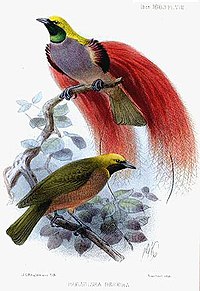
Photo from wikipedia
Abstract Sexual selection is a key evolutionary force but varies widely between populations. Two key factors that influence sexual selection are the extent to which females copulate with multiple males… Click to show full abstract
Abstract Sexual selection is a key evolutionary force but varies widely between populations. Two key factors that influence sexual selection are the extent to which females copulate with multiple males (polyandry) and variation in the social environment. Increasing research demonstrates populations are structured by complex socio‐sexual networks, and the structure of these networks can influence sexual selection by shaping the relationship between male precopulatory mating success and the intensity of postcopulatory competition. However, comparatively less attention has been dedicated to the influence of group structure on sexual selection and how differences in the size of groups may impact on the relative force of pre‐ and postcopulatory sexual selection in polyandrous populations. The presence of groups (i.e., group structure) and the size of groups varies widely in nature and forms an implicit part of much experimental sexual selection research under laboratory conditions. Here I use simulations of mating competition within populations that vary in the size of groups they contain, to show that variation in group size, and in particular small groups, can influence sexual selection. Specifically, I show that null expectations for the operation of pre‐ and postcopulatory sexual selection is governed by the size of groups within populations because smaller group sizes constrain the structure of sexual networks leading to reinforcing episodes of pre‐ and postcopulatory sexual selection. Given broad variation in group structure in nature and the tendency for experimental sexual selection research to study replicate small groups, these effects have implications for our understanding of the operation of sexual selection in polyandrous populations.
Journal Title: Ecology and Evolution
Year Published: 2023
Link to full text (if available)
Share on Social Media: Sign Up to like & get
recommendations!